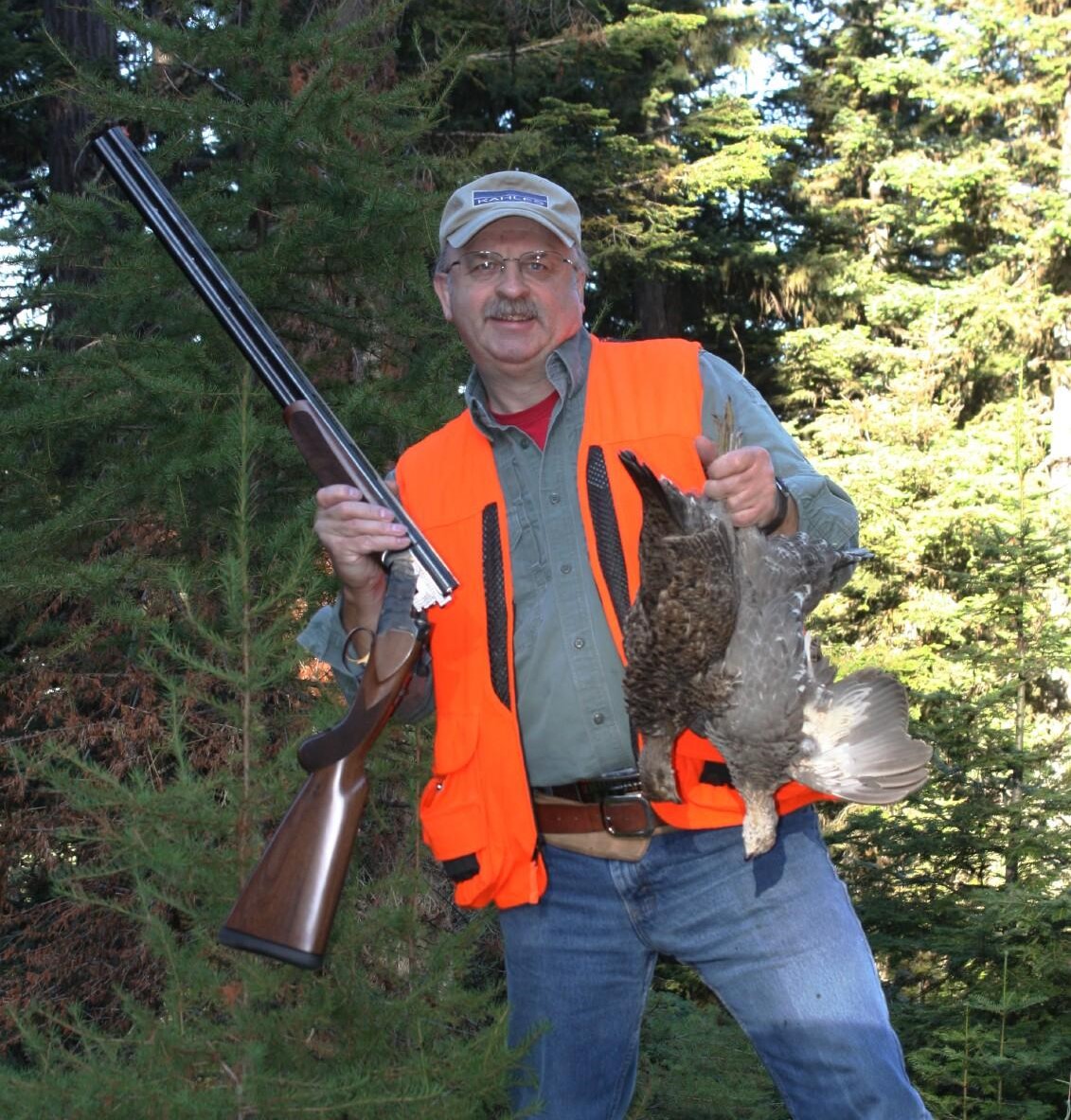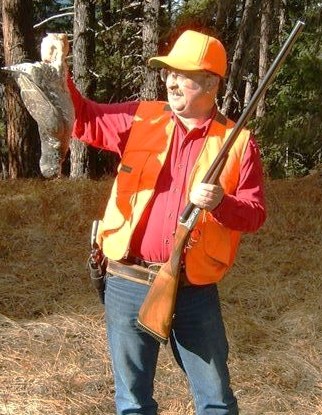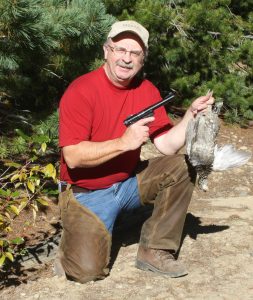
By Dave Workman
Editor-in-Chief
The forecast for September is definitely calling for “fowl” weather, especially for the legions of upland wingshooters for whom grouse—be they lowland ruffed, high-country blues (‘dusky’ or ‘sooty’), spruce or sharptail—are the ultimate challenge.
The first shots of the season come this Saturday, Aug. 30 in Idaho, which always seems to have the earliest opener, followed by several states—Montana, Oregon, Wyoming and Colorado—which open their seasons on Monday, Sept. 1.
They’re followed by California and Minnesota on Sept. 13, Michigan and Washington on Sept. 15, New York (yellow area) Sept. 20, Maine and Vermont on Sept. 27, New York (light blue area) and New Hampshire on Oct. 1, Pennsylvania, Massachusetts and Connecticut on Oct. 18, and Ohio on Nov. 7.
What is it about grouse that beckons upland shotgunners? Well, let’s see:
- They don’t flush from cover, they explode in a flurry of thundering wings; a launch sometimes so unnerving one actually forgets to shoulder his or her gun and open fire.
- They’re not so easy to hit, especially in cover which frequently includes a mix of vine maple, alder, assorted conifers and ground brush in which they hide until it’s time to startle the beejezus out of everyone within range.
- As table fare, they are considered at the top of the menu, because they are large enough to provide a great main course. This is especially so for the western blue grouse, also identified as “dusky” or “sooty” by people who evidently didn’t have more important things to do than categorize fool hens.
Grouse hunters in the East and upper Midwest most often rely on good hunting dogs, and are “purists” in the sense that they use shotguns, fire at birds only on the wing, and might consider it blasphemy to ever plug a bird with a rifle or pistol.

Grouse hunters in the West enjoy shooting them on the wing, don’t necessarily hunt grouse with dogs, and have discovered generations ago that birds popped in the noggin with a .22 rifle or pistol taste just as good and the diner isn’t preoccupied with gently biting his or her next mouthful in order to avoid crunching down on a piece of shot.
All kidding aside, no matter how one chooses to take a bird—we recently heard from one Canadian gent who confessed to having bonked birds with an airgun!—the reward is memory-filled action, sometimes amazingly lucky shots, and sometimes misses so frustrating all one can do is laugh, shake his or her head and reload for the next bird.
I’ve been hunting grouse longer than any other game, big or small. My first grouse experience was a disaster, memorable only because my dad tried to get me to be patient and I failed miserably. We were hunting on the backside of a mountain south of Randle, Washington and trotting up the road ahead of us had to be the absolute dumbest blue grouse on the planet. This idiot wouldn’t fly, he wouldn’t even flex his wings. All this bird would do was scamper along, and, fearing he would vanish into the bush along what might generously have been called an “old logging road” I cocked the hammer of my single-shot 16-gauge Harrington & Richardson full-choke shotgun without a front bead—dad had traded a guy, using a Beretta pistol as his bartering fodder, as I recall, because he couldn’t afford to buy me a shotgun—and I cut loose with a load of No. 6s. There wasn’t much left of that poor bird, and I wasn’t terribly proud of myself, but in retrospect, it was a shot that turned me into a devoted, and far more patient and attentive, grouse hunter.

My subsequent birds were all in very good shape, and I hunted with that single-shot relic, with its kinda-loose barrel, until my late teens when I saved enough to buy a second-hand Beretta 12-gauge side-by-side with fixed full and modified chokes, double triggers and a nickel-plated receiver with roll engraving. It had a straight grip stock with decent checkering, a Monte Carlo comb and a recoil pad I eventually replaced, but it fit me rather well and the price was remarkably low for that good a smoothbore. Today that gun occupies a special place in my gun safe, “semi-retired” as it were, since I started using a 20-gauge over-and-under.
Ruffed grouse are such a fine challenge that many years ago, devoted hunters created the Ruffed Grouse Society to make sure this species flourished. They’ve done a decent job of it, in my opinion, and one can see how their efforts have paid off by the hunting opportunities in the U.S. and Canada.

Nobody ever formed a Blue Grouse Society, probably because, as a species, they often exhibit the intelligence of a doorknob. I have personally shot, and seen others do likewise, blue grouse which have flushed only to land on the nearest tree limb well within range, and just sit there pretending to be invisible. Hasn’t worked so far!
Blue grouse are not called “fool hens” for no reason!
They’re a high country fowl, found in the Rockies and Cascades, all the way up through western Canada and into Alaska. The biggest of western grouse, I’ve taken birds which, when breasted, provided dinner for two people!
One of the best shots I ever made on blue grouse was way up in the central Cascades. I jumped two birds, missed the first one, and when the second took flight, winging sort of downward over a rock slide to gather speed before heading into the timber, my swing was perfect and at about 25 yards he folded to a payload of No. 6s fired out of the aforementioned Beretta. My only complaint was that I had to carefully make my way down that bloody rockslide to retrieve the bugger.
But, having been feeding on wild huckleberries and assorted greens, he tasted superb!
With dogs in on the action, grouse will hold tight until they decide to shatter the quiet in a flurry of wings. We don’t call ‘em “thunderchickens” just for laughs. The launch of a nervous grouse is an explosion of chaos, and when there are two in the air, it’s pandemonium. This is also what makes grouse such a great quarry. Ruffed grouse are fast and furious, and for those hardy souls who beat the hardwoods for birds, my hat is off.
But I confess to enjoying the blue grouse most of all. Perhaps I am, as one guy once suggested, a “might tetched in the head,” but whether clobbering them with a smoothbore, or conking them in the noggin with a .22 pistol or scoped Ruger 10/22 rimfire rifle, I’ve never had misgivings about the outcome, nor any feeling of guilt.
Most people have their own grouse recipes, but I prefer simplicity. Normally, I will breast the bird and take the legs, warm up a cast iron skillet with a little butter and a couple of strips of bacon, and slow cook my birds along with sliced potatoes and onions. Around a campfire, nothing tastes much better.
Bigger blue grouse breasts can be substituted for chicken breasts to provide the meat portion of “grouse parmesan” or some other pasta-based meal, and the results are also delicious. Seasoned with a little pepper and—believe it or not—a good steak rub, grouse can spoil one’s appetite for domestic fowl.
But be forewarned. Grouse hunting is addictive. Come this weekend, and in the weeks ahead across the grouse states, you will find out why.


